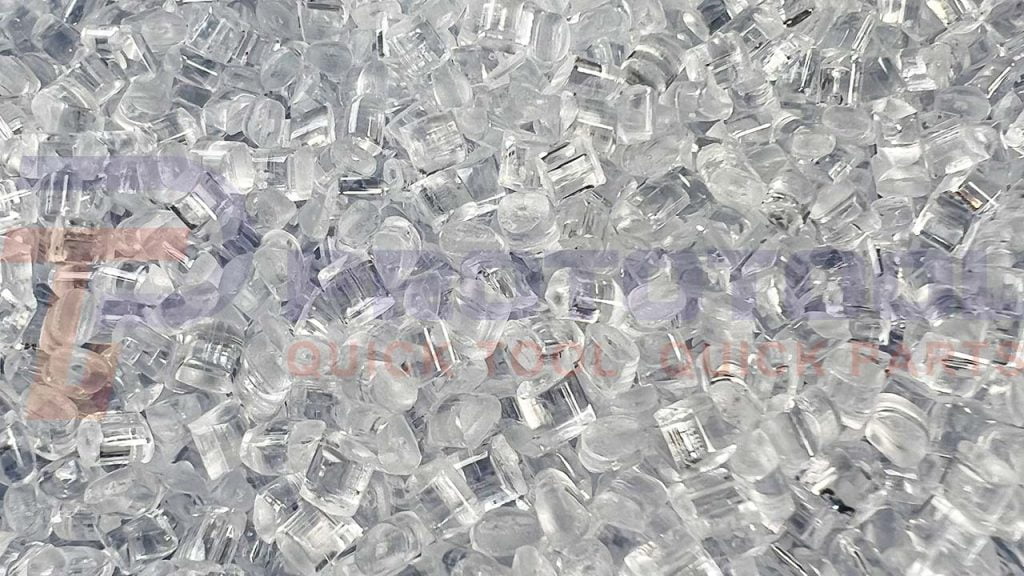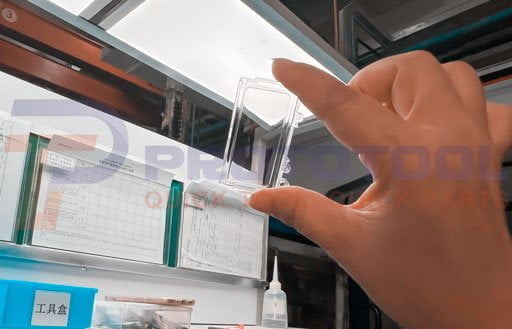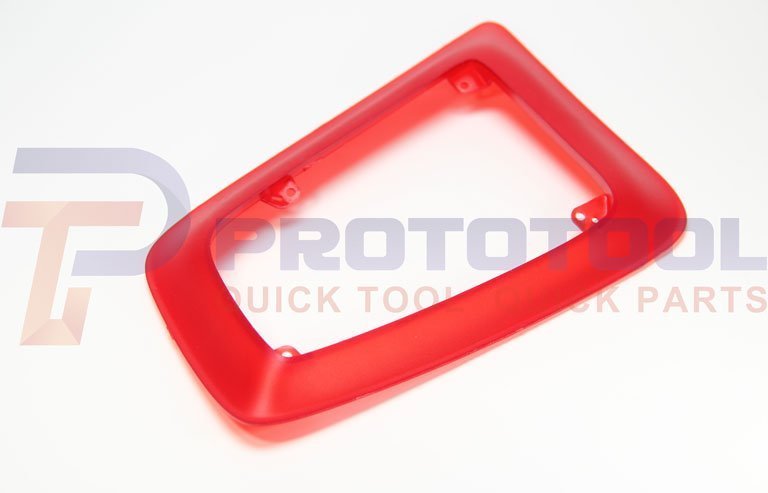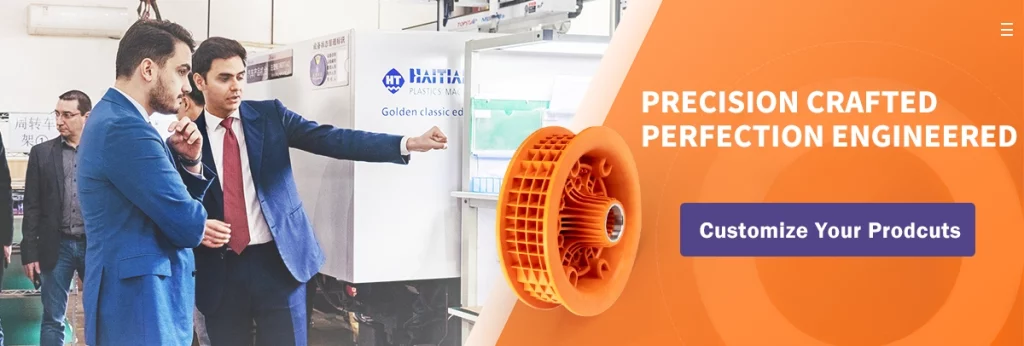Suppose you ever happen to visit a clear injection molded plastics factory. In that case, you will notice that clear plastic injection molding involves melting a raw material, pushing the viscous fluid into a molde de inyección, and allowing it to cool and harden.
Almost every product, from electronics to home goods to automobiles to food packaging, uses molded components. Even though it appears to be a relatively easy operation, there is a lot of science involved in performing it correctly, from making the molds to comprehending the chemical and physical characteristics of the materials.

In this guide, you will learn everything about clear injection molded plastics. It also includes the technology’s fundamentals, materials, characteristics, and helpful design advice.
Let’s start.
Introduction To Clear Plastic Injection Molding
Clear plastic injection molding is a manufacturing technique that enables the mass production of components through injection molding. The process involves pumping molten materials into a mold, which is usually used in mass manufacturing to create thousands of similar goods. Metals, glassware, elastomers, and sweets may all be molded by injection molding.
Characteristics of raw materials used in clear plastic injection molding

● Material Flexibility
A material’s flexibility and softness are frequently misinterpreted. The capacity of a product to resist bending under intense pressure is referred to as stiffness. The material’s capacity to mold and bend under pressure without tearing or wasting determines its flexibility.
For instance, ABS is a strong plastic that is yet quite flexible. Before it starts to shatter, it may bend to a significant extent. When under strain, nylon polymer quickly breaks.
● Material Weight
En attribute of material weight affects the final product’s weight and density. For instance, polyethylene is the best material if you need something light, and nylon is a rigid injection molding material to tackle if you require a hefty substance.
● Material Cost
Material cost is undoubtedly crucial when making china clear injection molded plastics. However, it’s crucial to base material choices more on the product’s use than just on price.
● Chemical Resistance
Cada clear injection molded plastics manufacturer looks for great chemical resistance quality for a product that can operate in various environmental circumstances. The best materials for this purpose include nylon, polycarbonatey acrílico, and these substances must be impervious to moisture, acids, and alkalis.
Problems That May Occur During The Clear injection Molding Process
While making clear injection molded plastics, we should consider the following problems to avoid bad backflow or uneven cooling, which may cause poor plastic molding, surface flaws, and overall molding design degradation.
- Transitions should be gradual and seamless to avoid sharp edges. Los productos de PC, en particular, no deben tener huecos debido a la producción de bordes afilados.
- En ángulo de calado debería ser suficiente, y el espesor de pared debe ser lo más uniforme posible.
- En superficie del molde debe estar libre de crestas y tener una rugosidad no superior a 0,8.
- Debe ajustar la ubicación de la compuerta siguiendo el proceso de condensación por contracción, y la ruta de flujo debe ser tan amplia y gruesa como sea factible.
- El grosor de las paredes no debe ser inferior a 1 mm, salvo en el caso de los animales domésticos.
- El depósito debe tener una gran abertura de ventilación que sea suficiente para liberar el aire y el gas mientras se funde.
Factores a tener en cuenta para minimizar la tensión interna y los defectos de calidad superficial
- Dada la hipótesis de que resina plástica no se desintegra, la temperatura de inyección debe ser alta.
- Utilizando un tornillo especial y máquina de moldeo por inyección con control de temperatura independiente boquilla se recomienda.
- Presión de inyección suele ser fuerte para superar el defecto de alta viscosidad de la masa fundida, pero producirá tensión interna si es demasiado alto, lo que provoca un mal desmoldeo y deformaciones.
- Velocidad de inyección: Suele ser lenta durante el llenado de un molde. Es preferible utilizar una inyección en varias fases lenta, rápida y lenta.
- La velocidad del tornillo y la contrapresión deben ser tan bajas como sea factible para satisfacer la calidad de plastificación y evitar la probabilidad de depreciación.
- El enfriamiento influye significativamente en la calidad del producto final. Como resultado, la temperatura del molde debe ser precisa en el control de la operación, y la temperatura del molde debe ser lo más alta posible.
- Si el relleno del producto es satisfactorio, no hay abolladuras ni burbujasy debe ser lo más breve posible para reducir el tiempo de permanencia de la masa fundida en el barril.

Materias primas comunes utilizadas para fabricar plásticos transparentes moldeados por inyección
Contrariamente a moldeo por inyección poco claroEl moldeo por inyección de plásticos transparentes requiere una mayor atención a los detalles y unos controles de fabricación más estrictos. Saber qué plástico transparente que mejor se adapte a sus necesidades.
Esta es la lista de proveedores de plásticos transparentes moldeados por inyección materias primas más comunes recomendadas para fabricar plásticos transparentes moldeados por inyección.
Acrílico
Uno de los polímeros más utilizados en el equipamiento de exteriores es el acrílico. También es muy solicitado en productos como luminarias, expositores comerciales, reflectores y lentes de color por su capacidad para distribuir por igual aplicaciones de aditivos como colorantes por toda la pieza durante el proceso de moldeo por inyección.
Nylon (PA)
Una variedad de hebillas de cierre rápido de nylon están hechas de nylon (PA). Otro nombre del nailon es PA, y su símbolo químico (poliamida). Con ello se pretende demostrar la robustez y adaptabilidad de la resina de nailon. Los componentes mecánicos resistentes, como casquillos, engranajes y cojinetes, suelen fabricarse con nailon. Se utiliza mucho en aplicaciones de automoción porque, además de ser duradero, contribuye a reducir el peso y abaratar los costes de producción en comparación con un equivalente metálico.
Policarbonato
Policarbonato es más costoso que los otros dos polímeros y es un sustituto resistente a los impactos. Es más fuerte y mucho menos sensible a las altas temperaturas que el acrílico. Sin embargo, tiene la misma transparencia y protección UV. Gafas de seguridad, cascos, escudos, contenedores de alta resistencia y ventanas de seguridad son sólo algunos ejemplos de artículos fabricados con este plástico destinado a soportar tensiones.
Polietileno
El alto calor y la presión convierten el petróleo en el termoplástico conocido como polietileno de alta densidad (HDPE). Al igual que el acrílico, es resistente a los rayos UV y versátil, con la ventaja añadida de ser fácil de moldear. Estas características, unidas a su bajo coste, hacen que se utilice en la producción en serie de artículos tan populares como botellas, tuberías y recipientes.
Caucho termoplástico (TPR)
una foto de un TPR rubber-made medical catheter. Thermoplastic Rubber (TPR) resin, which is simple to use in the injection molding process, is a blend of plastic and rubber. TPR is employed in various fluid dispensers, flexible hoses, catheters, and other locations holding various liquids, including acid.
Thermoplastic Polyurethane (TPU)
Thermoplastic Polyurethane (TPU) has excellent tensile and tear strength while being soft and elastic. TPU makes it easier for objects that need to be grasped firmly in hand to grip. However, you should know that TPU is more expensive than other resins. Because of this, it’s frequently utilized to create components that require rubber, such as elasticity.
Polipropileno
Polipropileno, sometimes referred to as PP, is frequently utilized in textiles, packaging, and containers. The textile sector is frequently used in products like waterproof bags, totes, and gear. Due to its great flexibility, it is perfect for living hinge applications and other non-load-bearing elements. Due to its high electrical resistance, it is also utilized in electronics.
Polyetherimide
A typical plastic used in mechanical, chemical, and industrial parts is polyetherimide (PEI). Its use may be seen in temperature sensors, heat shields, aircraft engine parts, and various electrical equipment and coverings. Due to its resistance to high temperatures and repeated stresses, this transparent material is frequently used in the automotive, electrical, and medical industries.
Defects and solutions of clear plastic parts
This part of the guide will cover defectos impacting product transparency and their solutions. The most likely defects are as follows.
Bubbles
When the resin is condensed in a mold, water vapor and other gases are not released, or the condensation surface condenses too quickly, owing to inadequate filling, creating a vacuum bubble.
Silver streak
Internal stress anisotropy is impacted by the filling and condensing process. The stress in the vertical direction forces resin to be orientated on flow, whereas non-flow orientation results in a variable refractive index and creates a flashing silk pattern. Its expansion might result in product fractures.
Seismic pattern
refers to a thick groove formed from the core of the sprue. The front-end material has been condensed in a cavity due to excessive melt viscosity. When the material is broken through the condensation surface, it appears as a seismic pattern on the surface.
Poor surface gloss
Because of the high mold surface roughness and the premature condensation that results from it, the surface of the cattle is somewhat uneven, and the product is tarnished.
White smoke/Black spot
The primary reason it forms is that when plastic is within a barrel, the resin degrades or breaks down due to localized overheating.
Whitening/Haze
Haze is mainly brought on by raw material with excessive moisture or dust dropping into it from the air.
Conclusión
The simplest method for producing several similar objects in bulk from unprocessed plastic polymers is plastic injection molding. When we consider what it does, it is a cost-effective strategy. The advantages of plastic injection molding are widely promoted. It’s perfect for the reliable, cheap manufacture of a variety of challenging, sophisticated plastic parts. We have covered everything you need to know about injection molding in this article, but there is still much to learn.











